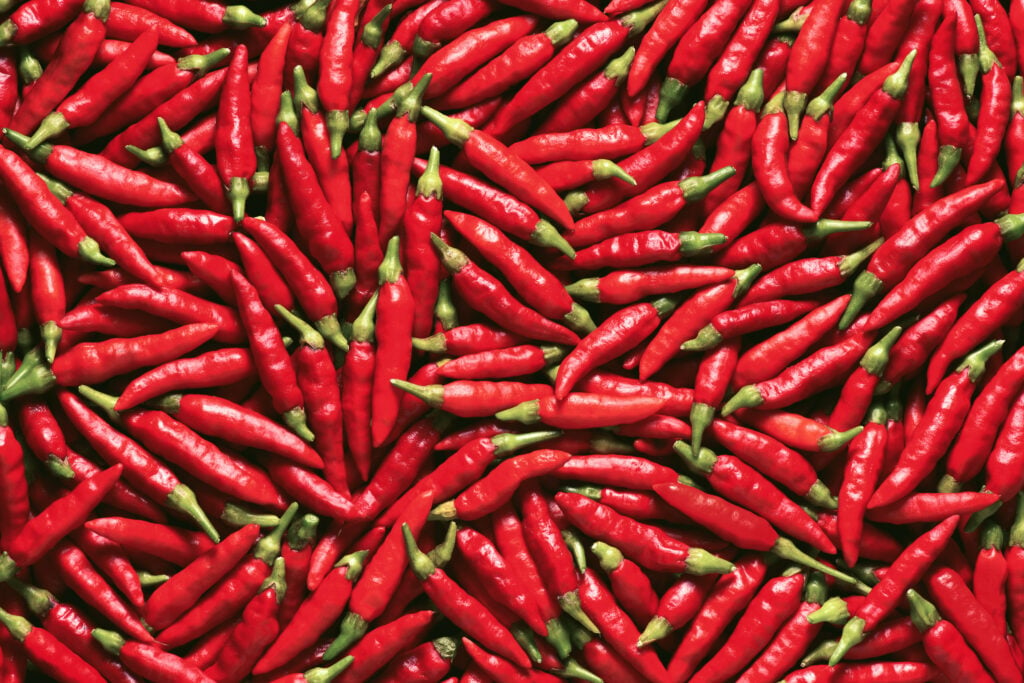This article originally appeared in the Washinton Post and is reprinted with permission from the author.
What was state of the art in 1912 has mostly fallen by the wayside. Cars have replaced horses. Washing machines have replaced washboards. Air travel, refrigeration and container shipping have transformed the way we live — and that’s before we even get to the internet.
So why, oh why, on God’s green Earth are we still measuring chile pepper heat on the Scoville scale?
Of all the units that measure all the things, Scoville heat units have got to be the most antediluvian. This is in no way a diss of Wilbur Scoville, the pharmacist who came up with this way of measuring pepper pungency back in, yes, 1912. And in 1912, it was genius.
Here’s how it works: Take a pepper, dry it, and dissolve it in alcohol. Then, start diluting it with sugar water. Keep diluting it until three of a panel of five humans — yes, humans — can no longer taste the heat. If you have to dilute one unit of capsaicin-infused alcohol with 10,000 units of sugar water for the pepper’s flavor to be undetectable, that pepper rates 10,000 on the Scoville scale.
It was a great system, because humans turn out to be very good at detecting capsaicin.
But they’re not nearly as good as high-performance liquid chromatographs.
The heat in peppers comes from a group of chemical compounds called capsaicinoids. The most common is capsaicin, so we generally use that as shorthand for the heat-producing element, but there are lots of others.
And here’s the thing about capsaicinoids: We can measure them. Without diluting them in gallons of sugar water. Without assembling a panel of humans who have different perceptions of heat and palates that get fatigued pretty easily. Detecting capsaicin is absolutely, positively a job for a machine.
“Humans differ. We vary in our taste buds and receptors,” Paul Bosland told me, “but with a machine, we can measure very accurately.” Bosland, now retired, studied chiles at New Mexico State University, and his name is so closely tied to capsaicin that, when the school raised $1 million to endow a professorship devoted to pepper research, officials named it after him. (The gifts official at the school, when explaining that the interest on the money will pay the professor’s salary, said, “That is to ensure that we will have chile research eternally.”)
The machine in question is that high-performance liquid chromatograph (HPLC), which can separate the capsaicinoids from the other components in the pepper and tell you just how many there are in parts per million (PPM). No taste buds required.
This is not a secret in the food industry, where machines are widely used and panels of tasters are mostly a thing of the past. Although an HPLC will set you back some $50,000 to $70,000, once you have it, the testing is only about $100 a sample, according to Bosland. Try recruiting a panel of five humans for that price!
Pure capsaicin, in parts per million, is 1 million PPM. One PPM translates to 16 Scoville units, so that scale tops out at 16 million. The Carolina Reaper, one of the very hottest peppers going, comes in at 2.2 million Scoville, but there’s an entire subculture devoted to growing — and eating — superhot peppers, so an even hotter variety could come along any day now.
For the rest of us, the peppers we’re likely to encounter run the gamut. Jalapeños generally come in at 4,000-8,000. Hungarian hot wax peppers are in the 5,000-10,000 range. Serranos are 10,000-25,000, and habaneros, the hottest peppers most of us are likely to cook with, start around 100,000 and can top 300,000.
And those ranges are maddening. You can grow the same kind of pepper in the same field and get different heat levels depending on environment, weather, and ripeness. If it’s a different cultivar, and you’re growing it in a different place, it’s capsaicin content chaos! When you’re trying to manufacture a food that’s supposed to taste the same every time, that’s inconvenient. Manufacturers are used to this, Bosland told me, and will use a combination of peppers to get the heat level they want.
The capsaicin content doesn’t tell you everything, of course. Peppers also have what Bosland calls a heat profile. “When you take a bite, how fast does the heat come on? Is there a delay? How long does that linger? Where do you sense it — at the tip of your tongue? At the back of your throat? And is it a sharp or flat heat? Sharp is like pins sticking you, and flat is like a paintbrush on your tongue.”
And then there’s flavor. With a very hot pepper, it’s hard to taste past the heat, but peppers have fruity and earthy and smoky flavors, too. When Old El Paso wanted jalapeño’s flavor, but not its capsaicin, to blend into its products, Bosland was able to grow a heatless jalapeño — and it won him the 1999 Ig Nobel Prize in biology, he told me with a laugh. (Ig Nobel Prizes, parodies of the Nobel Prizes, honor achievements that make people laugh, think, roll their eyes or scratch their heads.)
Now that we’ve covered the basics of peppers, let’s go back to the original question: When we can measure parts per million, why are we still using Scoville heat units? For starters, the food chain is actually measuring capsaicin in PPM, so what’s the point of converting it to a horse-and-buggy-era scale? Then there’s the fact that, by multiplying PPM by 16 to get Scoville units, you make the ratings even more counterintuitive than PPM; 10,000 sounds like a lot, but it’s actually just a little. There’s got to be a better way.
Allow me to propose an alternative. A simple 1-to-10 heat scale, based on the capsaicin content of the chile peppers most of us encounter. Let’s use habaneros to anchor the top end of the scale (and superhot peppers can be over 10). Poblanos are a 1. Jalapeños are a 2, and so on, in a perfectly understandable, simple scale based on a number we can measure.
I thought this was a genius, original idea until I went to the Scoville scale website and saw that it breaks peppers down exactly this way.
I believe what’s preventing this simple, 1-to-10 scale from catching on is the lack of a good name. Scoville was on to something when he decided to name his scale after himself, so I’m going to take a page from his book. Since I’m not getting any younger, and opportunities for immortality are thin on the ground, I think we should name this scale after me.
From this day forward, pepper heat will be measured in Haspels. A habanero is a 10-Haspel pepper. Old El Paso will make sure its salsa rolls in at 1.8 Haspels. I will be on the signs in the pepper sections of all the grocery stores. This is particularly appropriate since Haspels measure a substance that can, in quantity, be pretty irritating.
You’re with me. I know you are.



High quality websites are expensive to run. If you help us, we’ll pay you back bigtime with an ad-free experience and a lot of freebies!
Millions come to AmazingRibs.com every month for high quality tested recipes, tips on technique, science, mythbusting, product reviews, and inspiration. But it is expensive to run a website with more than 2,000 pages and we don’t have a big corporate partner to subsidize us.
Our most important source of sustenance is people who join our Pitmaster Club. But please don’t think of it as a donation. Members get MANY great benefits. We block all third-party ads, we give members free ebooks, magazines, interviews, webinars, more recipes, a monthly sweepstakes with prizes worth up to $2,000, discounts on products, and best of all a community of like-minded cooks free of flame wars. Click below to see all the benefits, take a free 30 day trial, and help keep this site alive.
Post comments and questions below
1) Please try the search box at the top of every page before you ask for help.
2) Try to post your question to the appropriate page.
3) Tell us everything we need to know to help such as the type of cooker and thermometer. Dial thermometers are often off by as much as 50°F so if you are not using a good digital thermometer we probably can’t help you with time and temp questions. Please read this article about thermometers.
4) If you are a member of the Pitmaster Club, your comments login is probably different.
5) Posts with links in them may not appear immediately.
Moderators